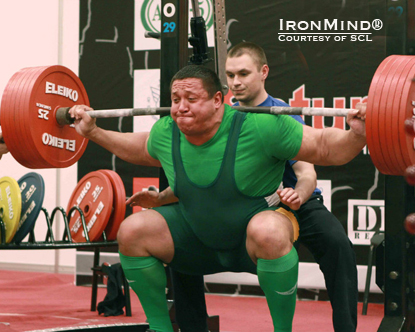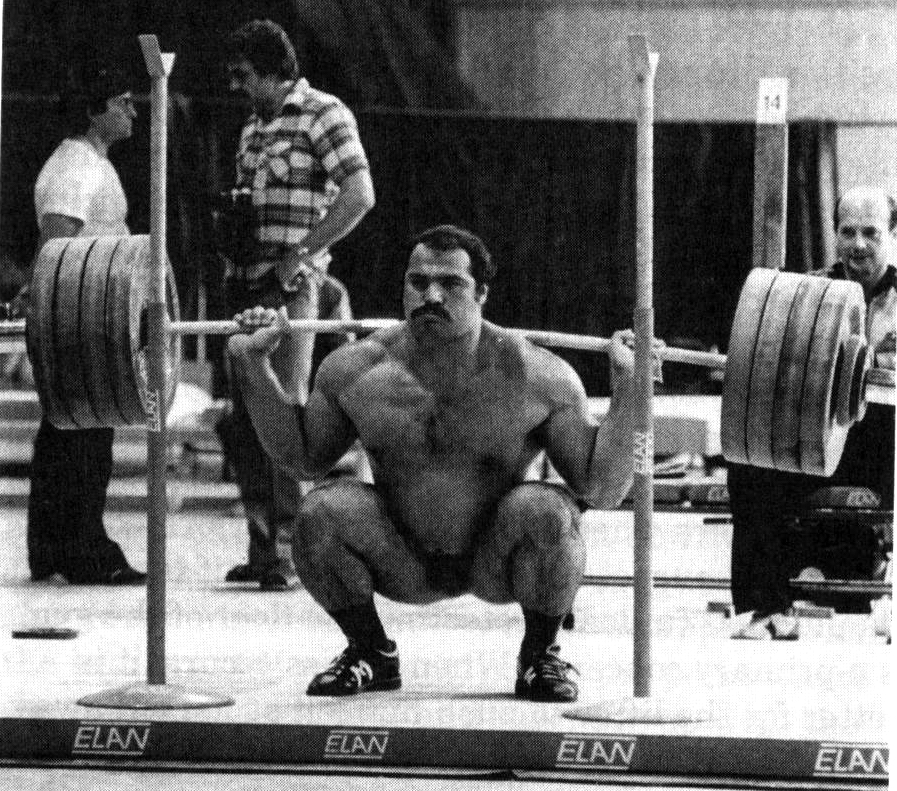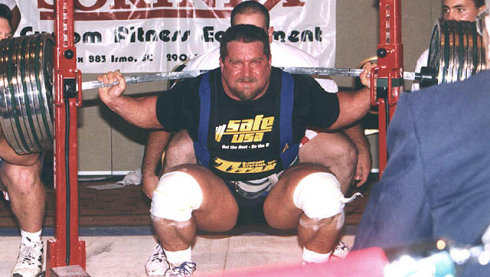Today’s article is a guest-post by raw powerlifter Greg Nuckols (see his bio below). Greg wrote a great article on glute training for powerlifters several months ago, and today’s article is just as excellent. Greg reviews one of my favorite papers on squat mechanics. In fact, last week, my two assistants and I put together a wooden model of body segments to help further explain the concepts included in this article. I’ll post a video on this in the next month or so. In the meantime, enjoy Greg’s review.
Forward lean in the squat – is knee-dominant or hip-dominant better for moving more weight?
By Greg Nuckols
This is a write-up for one of the classic studies in squatting mechanics – Kinetics of the Parallel Squat by McLaughlin, Lardner, and Dillman. I’ve seen it referenced in almost every study I’ve ever read about the squat, and I finally managed to find it full-text. And let me tell, you, for a nerd like me, it was page-turning excitement.
You see, whenever I saw this study referenced, it was to support the claim that better squatters squat in such a manner than that 1) minimizes forward lean of the torso and 2) maximized extensor-dominant thigh torques (quad-dominance instead of hip dominance). I’d always been taught the exact opposite – “butt back” was the first movement, and you should avoid the knees tracking forward over the toes – effectively making the squat as hip-dominant as possible.
I started becoming skeptical of that cue as raw lifting became more and more popular. “Hips back” makes a lot of sense when you’re squatting with a lifting suit because the suit primarily provides aid in hip extension. However, it seemed like a lot of top raw squatters let their knees track farther forward, and even the extreme quad-dominance seen in the weightlifting squat still produced plenty of insane squats, with a form I’d been taught was as wrong as you could possibly get!
Now that we have that background information out of the way, let’s delve into the study at hand.
The Subjects
The subjects were all competitiors in the AAU Senior National Powerlifting Championships in 1974. The authors grouped them into three groups. “A” group consisted of people whose squat was ranked either first or second for their weight class in the world rankings. “B” group consisted of people with a squat ranked in the top 10, and “C” group consisted of people with a squat ranked outside the top 10. This is important to keep in mind, because when the authors talk about “more skilled” or “less skilled” squatters, they’re still talking about really really good squatters. For example, the 4 squats classified in “C” group were 551 at 194, 511 at 220, 621 at 242, and 643 at 332. So, while “C” group squatters squatted less that group “A,” they weren’t weak squatters by any means!

The Procedure
It was a pretty straightforward study. They set up a camera system directly to the side of the competitors and tracked where the limbs and joints were by noting positions of the lateral malleolus, the lateral articulation of the knee, the greater trochanter, and the position of the bar across the back as the lifters moves. From this data, the authors were able to calculate torques about each joint based on how the subjects moved and the center of gravity for the system. Although corroborative EMG data (to compare muscle activation across a joint to the torques observed) would have been nice, the study obviously had to be totally non-invasive because it was done on lifters who were actually competing. However, that is actually a strength of the study – it observed people under maximal loads and maximal exertion. We all know that you can‘t necessarily extrapolate technique from submaximal weights to maximal ones, and that people often perform differently on “game day” than in training.
The Findings
1) The trunk torques tended to follow a pretty similar pattern for all the lifters. They increased in an extensor-dominant pattern (i.e. gluteus maximus, spinal erectors, and hamstrings producing more torque than the abdominals and the hip flexors, resulting in an extensor-dominant net torque) during the eccentric, peaking near the bottom of the movement, remaining near peak values through the sticking point (established in a previous study to occur when the thigh was at about a 30 degree angle to the ground), and decreasing during the concentric. When comparing group A to groups B and C, it was found that maximal torque did not increase linearly with weight of the lifter and weight on the bar. Conversely, the largest subject who lifted the most weight (I’m pretty sure it’s Don Reinhoudt, actually) exhibited lower trunk torques than four of the group B and C lifters who were considerably smaller and lifting far less weight.
2) The thigh torques didn’t have as clear of a general trend as the trunk torques did across all the lifters, however, maximal extensor-dominant thigh torques were generally seen in the bottom position of the squat, decreasing until the sticking point. Clear differences could be seen between people of different skill levels, however. The three group A lifters exhibited the largest extensor-dominant (i.e. quadriceps producing more torque at the knee than the hamstrings and gastrocnemius) thigh torques. This is not to be confused with merely having the strongest quads. It means that throughout the movement, the group A lifters’ quads were producing more torque relative to their hamstrings and gastrocnemii, resulting in a higher NET extensor torque.

Authors’ Conclusions
The basic conclusion of the authors is that to lift the most weight possible, a squatter should squat in such a manner as to decrease forward lean as much as possible. The trunk torques were, on average, much larger than the thigh torques, and they tended to increase as the lifter’s forward lean increased. This was supported by previous research by the same authors indicating that highly skilled lifters showed less forward lean. The authors believe the finding that higher skilled lifters have more extensor-dominant thigh torques is related to the goal of minimizing trunk torques. This conclusion makes sense, as staying more upright basically necessitates more forward tracking of the knees and a more quad-dominant lift.
Limitations
1) Anthropometric considerations were not taken into account when analyzing the data. For example, a longer femur relative to other body segments would necessitate more forward lean (and more extensor-dominant trunk torque along with it) to achieve proper depth. Less forward lean and more extensor-dominant thigh torques may not indicate skill in the lift, but may instead indicate ideal segment lengths for squatting a lot of weight.
2) It was an observational study, not an intervention. The authors did not train the subjects to squat in a more knee-dominant pattern and analyze the effects on performance – they simply observed that such a pattern tended to be used by the better squatters.
3) All the subjects, relative to the general lifting population, were VERY skilled squatters. They had to all be high-level lifters to even be invited to the AAU Senior Nationals. These findings MAY not be generalizable to the general population, or even the average gym rat.
Breaking it All Down
For starters, you can squat a lot of weight with a lot of different forms. There may be generalizations that can be drawn from the performances of the best in the world, but even the “least skilled” lifters in this study, with the most forward lean and the most hip-dominant squats, were still squatting weights that most people only dream of.
This study should not be used to argue high bar vs. low bar squatting. Although a more erect torso was found to be associated with a bigger squat, and high bar tends to facilitate a more erect torso, all of the subjects were competitors at a powerlifting meet, and more than likely were mostly low bar squatters. Most importantly, though, bar position was not stated, so it’s not a subject that’s even touched on by this study.
This is primarily a descriptive study, and any prescriptions that could be drawn from it would have to be tentative. Since there was no intervention, we don’t know what the actual effects would be of purposefully making the squat more knee-dominant. As previously mentioned, it could be that the best squatters were simply built in a way that facilitated a more upright, knee-dominant squat. However, it may be prudent, barring prior knee injuries, to at least try a squat stance that keeps the torso more erect: weightlifting shoes, more forward knee movement, and more hip abduction.
At the very least, this study should at least call into question the “butt back,” purposefully hip-dominant squat, at least for raw lifters. This is not to say that such a cue does not have a purpose, especially for new lifters who often have difficulty engaging their posterior chain musculature. However, at least for lifters with a little more experience, this study seems to suggest that purposefully making the squat more hip-dominant and increasing forward torso lean is not prudent if the goal is to squat as much as possible.

AUTHOR BIO
Greg is completing a degree in Exercise Science at Harding University and works at Mash Elite Performance in Advance, NC when he’s not in school. He competes in powerlifting and loves reading, researching, and experimenting so he can help others attain success in their own pursuits. His best lifts are a 750 squat, 445 bench press, and 725 deadlift, and his best meet totals are 1714 raw and drug free at 220, and 1885 at 242. You can get in contact with him at gregnuckols.wordpress.com, or via email at gnuckols@harding.edu.







As previously mentioned, it could be that the best squatters were simply built in a way that facilitated a more upright, knee-dominant squat. These guys were built to squat like this. Somebody like yourself would squat better but back.
I don’t know, study seems too small to be relevant
I just watched a WR raw squat of 450kg by Andrey Malanichev in which he performs a low bar with forward lean and knees with very little forward tracking
there are many more examples like this one .. study inconclusive in my opinion
Kieran, I completely agree about the importance of anthropometry here and that the best squatters are built to be more upright when sitting back. When I sit back, I fold like an accordion do to my lever lengths.
Great article!
What is your take on the whole concept of spreading the floor and keeping the knees out being challenged recently – with people siting examples of top weightlifters letting their knees drop in at the bottom of the squat and the ‘advantages’ of allowing this to happen?
cheers
Mark…not sure if you’re asking me or Greg, but as always I’ll chime in haha!
My take is that:
1) it’s not needed in contests (for maximum displays of strength) – see my blogpost “the keys to stronger squats” from last week…most of the lifters experienced some medial knee displacement.
2) it is needed in training as forcing the knees out helps keep the knees healthy, builds upper gluteal strength, and helps keeps a more upright trunk.
3) the vast majority of beginners need this cue as they cave too much and tend to have weak glutes and poor hip control. So as a personal trainer/strength coach this cue is a mainstay.
Just my two cents!
Phew that was a good read!!!
Perhaps the author of this nonsense should consider that when you add a restriction like depth (and consider the year of this competition and what was required for legal squats), this drastically impacts on optimal form. Within that constriction, more upright is better. WITHIN THAT CONSTRICTION.
Anybody with eyes knows that you can load more wheels sitting back than down, even raw. So this clearly fails the reality check at face value. You can LIFT MORE WEIGHT sitting back.
The confound of course is that you don’t squat as DEEP with a lower bar/more forward lean squat as with the higher bar. So whether or not muscular tension is as high or lower (or simply distributed differently) is debatable.
But the form by which you can lift more weight isn’t up to debate and a 40 year old study based on strictly performed legal PL squats doesn’t change that.
Lyle
totally agree… you can review dozens of videos of top elite RAW lifters and find that the majority of them do sit back there are several reasons why they do it but the #1 is you can move more weight period
I don’t think you added any facts to the discussion. “Anyone with eyes knows” isn’t true at all. Some of the biggest squats today are done with relatively straight torso.
As for 40 year old studies…. the human body hasn’t changed a lot since then. Nothing in that invalidates the observations.
Lyle, I think the focus here should be on trunk angle. The stronger squatters had more upright trunks. I’m sure that this has very much to do with anthropometry in that their femurs were shorter. If my memory serves me right, the study didn’t examine forward knee displacement. Perhaps the lifters are sitting back to the same degree as other lifters but their femurs are shorter and are therefore staying more upright. However, I think that in general, geared PL’ers do best with sitting back and keeping vertical shins, whereas raw lifters do best with staying a bit more upright and letting the shins drift forward slightly (where the ideal strategy is still sitting back but not so far back that it leads to too much forward trunk lean). Of course there are exceptions to every rule. But a good example of this is Eric Lilliebridge’s recent 925 lb raw squat. He’s still sitting back, but staying very upright: http://www.youtube.com/watch?v=fOMcmDh7UmE
Lyle, what I hear you saying is that sitting back is better, but only if you don’t have to break parallel. Of course, we’re talking about squatting in a PL competition, so isn’t depth sort of a necessary stipulation…?
Also, I said this wasn’t a high bar vs. low bar issue. And OF COURSE there is going to be some forward lean in the low bar squat just to keep the bar on your back. The issue is how much. It’s not that it’s totally upright vs. parallel to the floor. It’s probably more like 40 degrees vs. 50 degrees.
The best raw squatters won’t have a crazy degree of knee tracking simply because of the constraints of the low bar squat, but do they focus on staying as upright as possible – especially in the hole and coming out of it. They manipulate stance width, hip abduction, and knee tracking to accomplish that, so even if the first movement is “butt back,” the ultimate focus is minimizing forward lean.
Did you even read the article bro?
Lyle one day just one day you will post a reply without being an arrogant rude twat I have bought some of your excellent books but watching any post you write kind of makes me throw up in my mouth a little.
I’d give you way more kudos but again your emaciated visage and propensity for filthy dialogue and personal attacks means you really shouldn’t grace any other pages but your own where you can prattle on to your hearts content about dog shelters and your failed attempts at skating.
James,
I wholeheartedly agree with your assessment of Lyle’s remarks. There is no reason to treat others disrespectfully. If you disagree, simply state your opinion and supply a link that supports your ideas whenever possible.
Also with this being a pretty old study … most powerlifters back in those days had an oly lifting background so naturally their high bar squat was stronger than a sitting back low bar
Just an excellent study and analysis. Not related to any scientific data, I have naturally started squatting a bit more upright as my hip flexibility has improved. At a minimum this lets me know that it’s OK not to sit back quite as far as I thought I was supposed to.
Exactly. You don’t HAVE to keep vertical shins…it’s okay to let them migrate forward a bit so you can keep a more upright trunk. Not saying that you should look like an Oly lifter, just saying that there’s some wiggle room.
I agree. As you said, anthropometry must play a big role in this, and it’s a good reminder to all of us that when we’re helping someone, the standard, accepted, proper form for movement is a *start point* for figuring out what is right for that particular person. Humans are extremely variable.
Thank you for the info! Very interesting!
Lyle McDonald you’re such a douchebag.
Think of joint angles; maximal torque is generated from 40-60 degrees. I’m guessing that most of the low bar squatters on average break the 60 degrees.
https://youtu.be/fn-7oS9mitQ
Can’t argue with records …